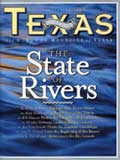
A Natural River
From the Pen of Robert L. Cook
Growing up in north-central Texas on Lost Creek, which at best could be called an intermittent stream, I always wondered what it took to be a river. Lost Creek drains into Pecan Bayou, which in turn feeds into the Colorado River near Goldthwaite. The Colorado, one of the major rivers of Texas, supports the Highland Lakes, from Lake Buchanan to Austin’s Town Lake, and hundreds of miles later, feeds into Matagorda Bay, one of the most productive estuary and bay systems in the world.
I have learned through the years that how we manage the land — even the watershed on our little ranch southeast of Abilene — really does impact the quantity and quality of water in places such as Marble Falls, Austin, Bastrop, LaGrange and Columbus. Throughout the state, private landowners now operate millions of acres of land under good wildlife habitat and range management plans on the watersheds of such rivers as the Brazos, the Trinity, the Colorado and the Guadalupe. Again and again we have seen the beneficial results of management plans on these waterways. I now understand how Lost Creek and similar watersheds play a critical role in the Colorado River system, which supplies fresh water for millions of Texans and for our fish and wildlife.
If my family — and private landowners like us — overgraze our land or allow it to become infested with mesquite or cedar, which suck up huge quantities of ground water, the people in Austin may not have water to drink. Spring-fed creeks like Lost Creek and rivers like the Pecos and the San Saba will dry up, providing no water for people, fish, wildlife or agriculture. If, on the other hand, we provide abundant ground cover on our ranchland by implementing deferred-rotation grazing, and if we use prescribed fire to control undesirable brush species and stimulate the growth and production of native grasses and forbs, the rain that falls on the vast private lands of Texas will be slowly filtered through those plants and soak into the protected soil. That same water will appear again in our springs, creeks and rivers for the use and benefit of all Texans, and for our fish and wildlife. On the other hand, the bare, baked ground that results from continuous overgrazing will cause the rapid run-off of rainfall, soil erosion and the deposition of vast quantities of sediment into our rivers, lakes and bays, seriously undermining the quantity and quality of our water supply.
The state of Texas receives millions of acre-feet of fresh, pure rainwater annually. It comes to us free, clean, crystal-clear and ready for all of our uses and needs. Almost all of the land on which this water falls is held by private landowners. We must manage and conserve every drop when and where it hits the ground. Through good land and watershed management, Texas becomes a huge sponge, absorbing, conserving and returning this abundant supply of fresh water from the Caprock in the Texas Panhandle to the bays and estuaries of the Gulf Coast. We must act now to insure an abundant supply of fresh water for future Texans. We can do it. Get involved: Be part of the solution.

